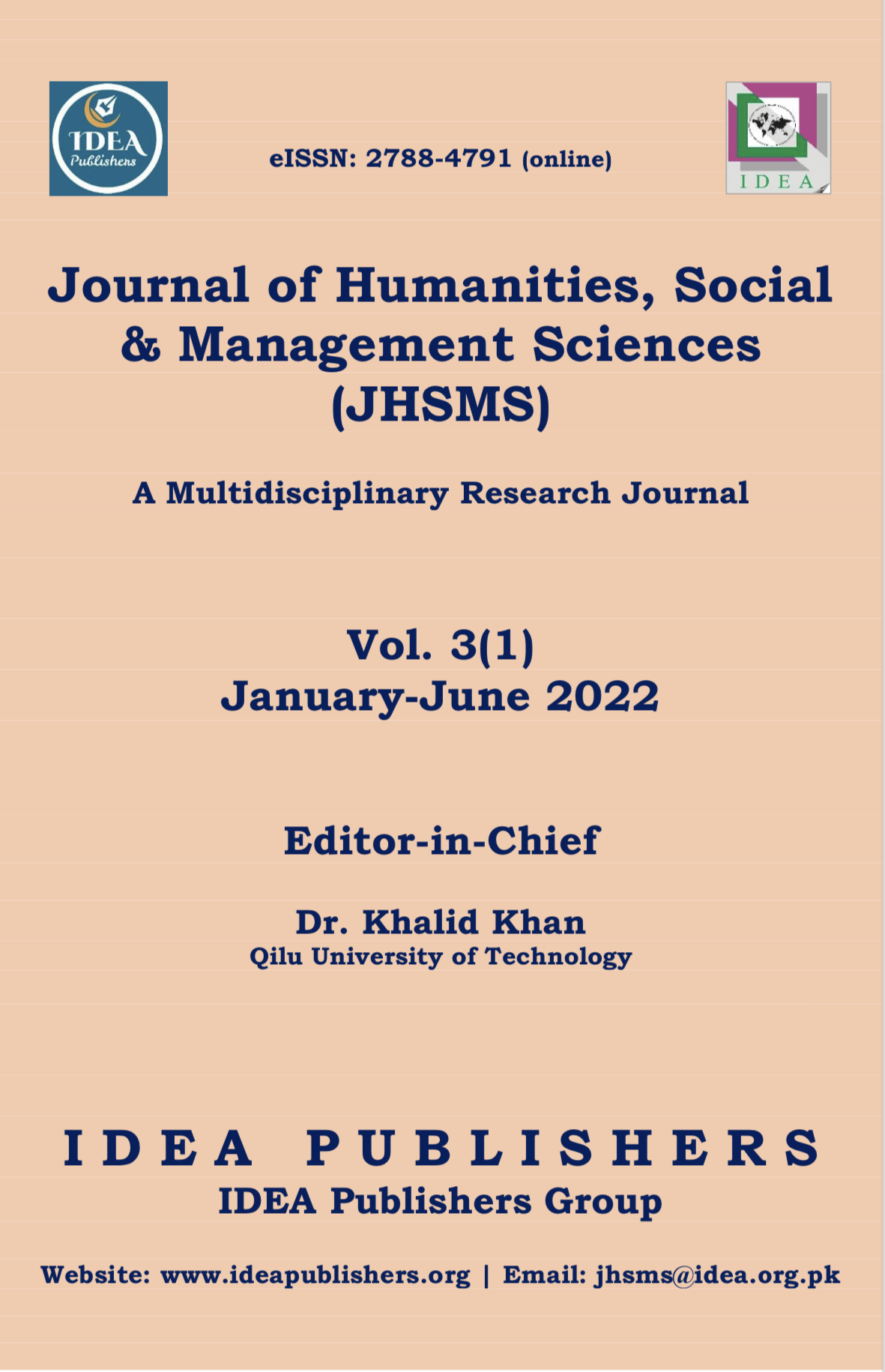Women malnutrition’s socioeconomic factors and consequences: a case study of district Peshawar, Pakistan
DOI:
https://doi.org/10.47264/idea.jhsms/3.1.9Keywords:
Malnutrition, women malnutrition, factors of malnutrition, consequences of malnutrition, poverty and malnutritionAbstract
The study was conducted in Peshawar district in order to find out the socio-economic causes of malnutrition among women. A descriptive type of study was conducted in the year 2020-2021. Data was collected from a sample of 393 from 5 different villages of Peshawar district. Sample size was selected by using the Yamane Formula. It was found that most of the women were married and had low level of education due to poverty. Most of the respondents were living in joint family system and were have economic reasons. 49.1% women had come across miscarriage and still births. 27.1% of the respondents were unaware of malnutrition as a serious health issue. 58.5% of the respondents were found with health issues diagnosed from year 24.7% were affected by malnutrition from different angles. 49.1% respondents were experiencing psychological issues due to malnutrition. More than 50% were having several health issues like high blood pressure, obesity, diabetics, eating disorder etc. 59.3% told that they were, or their families were facing economic issues which was the major cause of their malnutrition. 18.6% of the women were found that they were not eating enough meal, i.e., three times daily basis.
References
Aidoo, M. & Harpham, T . (2001). The explanatory models of mental health amongst low-income women and health care practitioners in Lusaka, Zimbia'. The Journal of Health Ploicy and System Research, 16(2), 206-213. https://academic.oup.com/heapol/article/16/2/206/644226?login=true
Bhagat, J. (2017, October 3). Top 16 causes of malnutrition. Stylecraze. https://www.stylecraze.com/articles/causes-of-malnutrition/#gref
Bureau Report. (2011, November 30). Malnourishment among women, children rising in KP, FATA. Dawn. http://www.dawn.com/news/676969
Correia, M. I. T., & Waitzberg, D. L. (2003). The impact of malnutrition on morbidity, mortality, length of hospital stays, and costs evaluated through a multivariate model analysis. Clinical Nutrition, 22(3), 235-239. https://doi.org/10.1016/S0261-5614(02)00215-7
Cueto, M. (2004). The origins of primary health care and selective primary health care. American Journal of Public Health, 94(11), 1864-1874. https://ajph.aphapublications.org/doi/full/10.2105/AJPH.94.11.1864
Dewan, M. (2008). Malnutrition in women. Studies on Home and Community Science, 2(1), 7-10. https://doi.org/10.1080/09737189.2008.11885247
Easton, V. J. & McColl, J.H (1997). Statistic Glossary (Vol.01).
Gavin, L. M. (2014). Hunger and your preschooler. Kidshealth.org. http://kidshealth.org/parent/growth/feeding/hunger.html#
Gomez, F., Galvan, R.R., Frenk, S., Munoz, J.C., Chavez, R., & Vazquez, J. (1956). Mortality in Second and Third Degree Malnutrition. Journal of Tropical Pediatrics, 2(2), 77-83.
Inam, M. (2016, January 17). How malnutrition is not only a medical issue, it is related to human rights. Dawn. https://www.dawn.com/authors/741/moniza-inam
Khan, M. M., Zafar, M. I., Ali, T., & Ahmad, A. (2009). Effect of socio-economic, cultural and demographic factors on woman reproductive health. Pak. J. Agri. Sci, 46(4), 308-314. https://pakjas.com.pk/papers/85.pdf
Khyber Pakhtunkhwa Population. (2017). Population of KPK Censes. http://www.pakinformation.com/population/kpk.html
Mirza, I., & Jenkins, R. (2004). Risk factors, prevalence, and treatment of anxiety and depressive disorders in Pakistan: Systematic review. BMJ, 328(7443), 794. https://www.bmj.com/content/328/7443/794.abstract
Pappas, G., Akhtar, T., Gergen, P. J., Hadden, W. C., & Khan, A. Q. (2001). Health status of the Pakistani population: A health profile and comparison with the United States. American Journal of Public Health, 91(1), 93-98. https://www.ncbi.nlm.nih.gov/pmc/articles/PMC1446517/
Pakistan Bureau of Statistics. (2017). Population censes. http://www.pbscensus.gov.pk/
Rebeeca, J., Stratton, C.J., & Green, M.,E. (2003). Disease realted malnutrition: An evidence-based approach to treatment. CAB International.
Saeed, H. (2016, January 17). Malnutrition: A layered problem. Dawn. https://www.dawn.com/news/1232897
Syed, H., Nigar, S., & Ullah, S. (2017). An analysis of household saving and investment behavior among different income groups in urban area of District Peshawar. iBusiness, 9(4), 188-202. https://www.scirp.org/journal/paperinformation.aspx?paperid=81318
Ullah, S., Malik, Z. K., & Khan, M. (2017). Economic assessment of the poverty-environmental quality nexus: A case study of Malakand Division. International Journal of African and Asian Studies, 33, 17-31.
Wakerman, J. Humpherys,S.J., Wells, R., Kuipers, P., Jones, A.J., Entwistle, P. & Kinsman, L. (2009, July 20). Features of effective primary health care models in rural and remote Australia: A case study analysis. http://www.mja.com.au/journal/2009/19/2/features-effectiv-primary-health-care-models-rural-and-remote-australia-case
World Development Report. (2004). Making services work for the poor people. World Bank.
World Health Statistics. (2015). Monitoring health for the SDGs, Sustainable Development Goals.
World Health Statistics. (2017). Monitoring health for the SDGs, Sustainable Development Goals.
World Health Organization (WHO). (2017). Malnutrition. maternal, newborn, child and adolescent health. http://www.who.int/maternal_child_adolescent/topics/child/malnutrition/en/
World Health Organization (WHO). (2011, March 16). Nutrition experts take action on malnutrition. https://www.who.int/nutrition/pressnote_action_on_malnutrition/en/
Yamane, T. (1967). Statistics: An introductory analysis (2nd Ed.). New york: Harpor and Row. http://uir.unisa.ac.za/bitstream/handle/10500/1935/07chapter7.pdf
Young, E.M. (2013). Food and development. Routledge.
Downloads
Published
How to Cite
Issue
Section
License
Copyright (c) 2022 Rabail Babar, Wasif Anis, Hafiza Dure Nayab Fareed, Sami Ullah

This work is licensed under a Creative Commons Attribution-NonCommercial 4.0 International License.
Please click here for details about the Licensing and Copyright policies of IDEA-PG.















